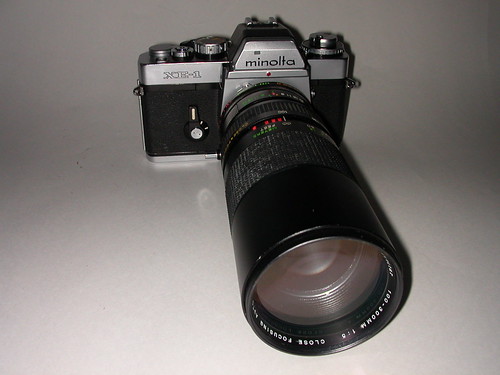Difference between revisions of "Minolta XE"
m (→Links) |
(contrib) |
||
| Line 5: | Line 5: | ||
|image_text= beautified XE-7 | |image_text= beautified XE-7 | ||
}} | }} | ||
| − | The '''[[Minolta]] XE''' | + | The '''[[Minolta]] XE''' is an electronic 35mm [[SLR]] camera introduced in 1974, just one year after the professional Minolta SLR [[Minolta X-1|X-1]]. It is called '''XE-7''' in North America, and '''XE-1''' in Europe and elsewhere. In many ways, this is a refined version of the X-1, but at the same time, the calibre is not quite in the professional league. It has a fixed finder and a slightly reduced shutter speed range. Despite quite similar body castings, the XE feels lighter and easier to handle, but still with a solid feel. Gone are all the unusual controls, and a few improvements are added as well. Of notice is the rear on/off switch, and next to it the frame counter film advance indicator confirming proper film transport. Also a multiple exposure lever was added, coaxial with the wind on lever. For multiple exposures, it must be operated each time. The traditional hot-shoe is at the top of the finder, while the finder shutter is a continuation of the previous model. |
{{br}}{{Flickr_image | {{br}}{{Flickr_image | ||
|image_source= http://www.flickr.com/photos/rst90274/265975792/in/pool-camerapedia/ | |image_source= http://www.flickr.com/photos/rst90274/265975792/in/pool-camerapedia/ | ||
| Line 12: | Line 12: | ||
|image_text= The XE, a relative of the Leica R3. | |image_text= The XE, a relative of the Leica R3. | ||
}} | }} | ||
| − | + | The '''Minolta Camera Co.''' entered in 1972 an agreement with[[Leica| Ernst Leitz GmbH]], to share patents, know-how and product development, possibly Kazuo Tashima's crown achievement. He travelled Europe before founding what later became the Minolta Camera Co, and the German camera industry had made a profound impression on him back then. The first camera to emerge from this joint venture was the Leica CL in 1973. Next came this camera as one of the fruits of this cooperation, also assisted by the [[Copal]] Company for the development of the vertical running metal blade shutter. The German [[Leica R3]]. version was introduced in 1976, and produced in Portugal, after a short run at Wetzlar. | |
== Links== | == Links== | ||
Revision as of 18:06, 30 May 2009

|
| beautified XE-7 |
The Minolta XE is an electronic 35mm SLR camera introduced in 1974, just one year after the professional Minolta SLR X-1. It is called XE-7 in North America, and XE-1 in Europe and elsewhere. In many ways, this is a refined version of the X-1, but at the same time, the calibre is not quite in the professional league. It has a fixed finder and a slightly reduced shutter speed range. Despite quite similar body castings, the XE feels lighter and easier to handle, but still with a solid feel. Gone are all the unusual controls, and a few improvements are added as well. Of notice is the rear on/off switch, and next to it the frame counter film advance indicator confirming proper film transport. Also a multiple exposure lever was added, coaxial with the wind on lever. For multiple exposures, it must be operated each time. The traditional hot-shoe is at the top of the finder, while the finder shutter is a continuation of the previous model.

|
| The XE, a relative of the Leica R3. |
The Minolta Camera Co. entered in 1972 an agreement with Ernst Leitz GmbH, to share patents, know-how and product development, possibly Kazuo Tashima's crown achievement. He travelled Europe before founding what later became the Minolta Camera Co, and the German camera industry had made a profound impression on him back then. The first camera to emerge from this joint venture was the Leica CL in 1973. Next came this camera as one of the fruits of this cooperation, also assisted by the Copal Company for the development of the vertical running metal blade shutter. The German Leica R3. version was introduced in 1976, and produced in Portugal, after a short run at Wetzlar.
Links
- Minolta XE-1, Minolta XE-5, Minolta XE-7 on www.collection-appareils.fr by Sylvain Halgand
| Minolta Classic Cameras |
|---|
| Vest (or Best) | V2 | SR-2 | SRT 101 | XE | XD | CLE | 7000 | 9000 | 800 si |